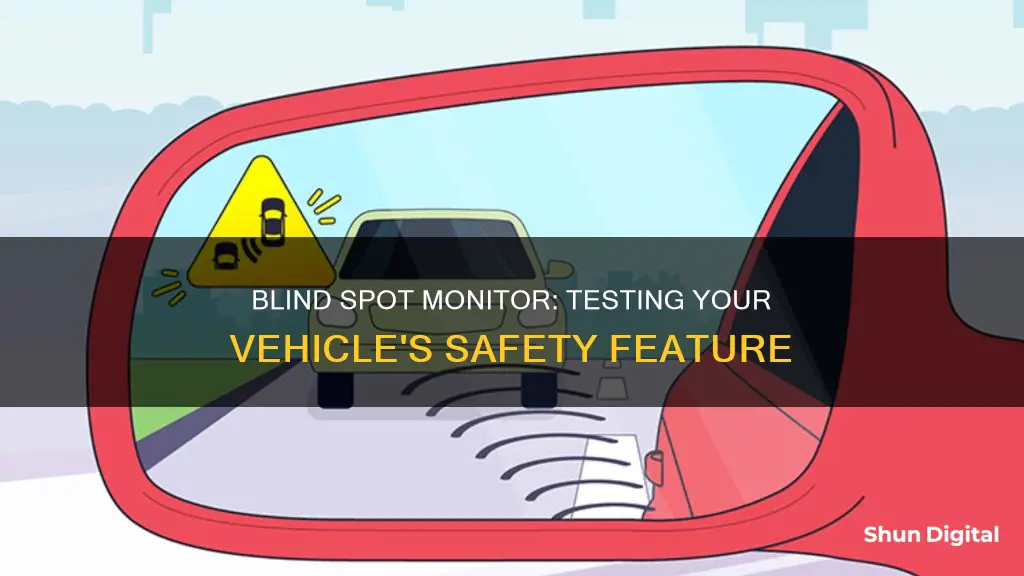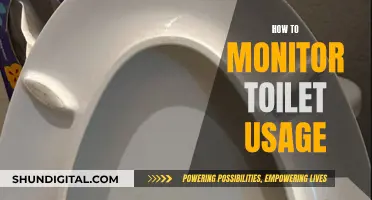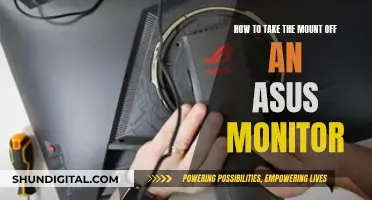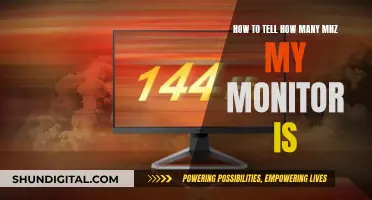
Blind spots are the areas to the sides of a car that can't be seen in the rear-view or side mirrors. Blind Spot Monitoring Systems (BSM or BSMS) are designed to help drivers avoid collisions with other vehicles or objects in their blind spots. They use sensors, cameras, or radar to detect the presence of vehicles or objects in adjacent lanes and alert the driver with a visual, auditory, or tactile signal. However, like any other electronic system, BSMs can malfunction or fail. To test a blind spot monitor, one should first check the warning lights on the dashboard or mirror. If the BSM warning light is on, it means the system has detected a fault and needs to be serviced. The next step is to inspect the sensors for any damage, dirt, or obstruction and to check the wiring and connectors for any loose or corroded contacts. The system can then be tested by driving the vehicle in a safe area and observing the signals, as well as by having another vehicle drive alongside and checking if the BSM detects it.
| Characteristics | Values |
|---|---|
| Purpose | Help drivers avoid collisions with other vehicles or objects in their blind spots |
| Function | Detect the presence of vehicles or objects in adjacent lanes and alert the driver with a visual, auditory, or tactile signal |
| Components | Sensors, cameras, or radar |
| Warning Lights | Check the warning lights on the dashboard or mirror; if the BSM warning light is on, it indicates a fault |
| Sensor Inspection | Inspect sensors for damage, dirt, or obstruction; check wiring and connectors for loose or corroded contacts |
| Testing | Drive the vehicle in a safe area and observe BSM signals; test at different speeds, distances, and angles |
| Troubleshooting | Check for common issues like low battery voltage, bad weather conditions, or interference from other devices |
| Maintenance | Regular inspections, clean sensors, follow manufacturer's recommendations, and avoid modifications |
| Limitations | May not provide a full assessment of detection performance and usability due to limited information shared by manufacturers |
| Criteria for Selection | Compliance with UNECE guidelines, field of view, detection of vulnerable road users, ingress protection, activation situations, and unit cost |
What You'll Learn

Check warning lights on the dashboard or mirror
Warning lights on the dashboard or side mirror are a key indicator of the status of your blind spot monitoring system (BSM). These lights are designed to alert you to any issues with the system, so you can take appropriate action. Here are some detailed steps and information to help you check and understand these warning lights:
- Location of Warning Lights: Depending on the make and model of your vehicle, the warning lights for the BSM can be found on the dashboard or the side mirrors. Typically, you will find these lights on the side mirror, usually in the form of a yellow or red indicator. Some vehicles may also have additional warning lights on the dashboard.
- Understanding the Warning Lights: When the BSM warning light is illuminated, it indicates that the system has detected a fault and requires service. This light may flash or remain continuously lit, depending on the severity of the issue. It is important to pay attention to this warning light and take your vehicle for service as soon as possible.
- Other Warning Lights: In addition to the BSM warning light, it is important to check other warning lights on your dashboard, such as the anti-lock brake system (ABS) or the electronic stability control (ESC) lights. Issues with these systems can impact the functionality of the BSM. For example, if the ABS light is on, it could indicate a problem with the vehicle's braking system, which may affect the BSM's ability to detect and respond to potential hazards.
- System Activation: In some vehicles, the BSM warning light will briefly illuminate when activated, usually when driving above a certain speed. This is an indication that the system is operational. The warning light will typically remain on while the transmission is in drive or neutral, and you may have the option to turn it off manually.
- Visual and Audible Indicators: Modern vehicles often have advanced driver-assistance systems that provide multiple types of alerts. In addition to visual warning lights, some BSM systems also emit a warning sound or provide tactile feedback, such as making the steering wheel vibrate when a vehicle is detected in your blind spot.
By regularly checking the warning lights on your dashboard and side mirrors, you can ensure that your BSM is functioning properly. If you notice any issues or illuminated warning lights, be sure to address them promptly to maintain the safety features of your vehicle.
Monitoring Bandwidth Usage: A Crucial Step for Network Efficiency
You may want to see also

Inspect sensors for damage, dirt or obstruction
To inspect the sensors for damage, dirt, or obstruction, you should first locate them. They are usually found behind the rear bumper or under the side mirrors. Once you have found the sensors, carefully examine them for any signs of damage or obstruction. Look for dirt, debris, or any other substances that may have accumulated on the sensors.
It is important to be thorough in your inspection, as even a small amount of dirt or obstruction can interfere with the sensor's performance and affect the accuracy and reliability of the blind spot monitoring system. Check the sensors for any physical damage, such as cracks, scratches, or other signs of wear and tear. If the sensors appear to be damaged, they may need to be repaired or replaced.
In addition to inspecting the sensors themselves, you should also check the wiring and connectors associated with the sensors. Ensure that all connections are secure and free from corrosion. Look for any loose or corroded contacts, as these can impact the performance of the sensors. If you notice any issues with the wiring or connectors, you may need to clean, repair, or replace them.
If you find dirt or debris on the sensors, you can carefully clean them using appropriate tools and methods. However, if you notice any significant damage or if the sensors are not functioning properly after cleaning, it is recommended to consult a professional mechanic for further assistance.
Guide to Choosing the Best ASUS 144Hz Monitor
You may want to see also

Test the system by driving and observing signals
Testing your blind spot monitor while driving is a good way to familiarise yourself with the system and its signals. While driving, you can test the system by observing the signals it gives you when there is a vehicle in your blind spot. This could be a visual signal, such as a flashing light in your side-view mirror, or an audible alert, such as a beeping tone. Some systems also offer a haptic alert, such as a vibration through the steering wheel or seat.
When testing the system, pay attention to the different types of signals and how they correspond to potential hazards. For example, some systems may give you a visual alert when a vehicle is approaching from an adjacent lane, while others may give you an audible alert. You can also test the system by activating your turn signal and observing if the alerts change or become more urgent.
It is important to remember that the blind spot monitor is not a substitute for checking your mirrors and performing a shoulder check before changing lanes. Always use your turn signals, watch your mirrors, and look over your shoulders to ensure a safe lane change. Additionally, keep in mind that blind spot monitors may not detect motorcycles or similarly-sized objects, so it is crucial to remain vigilant and use multiple sources of information to make informed driving decisions.
By testing and familiarising yourself with the blind spot monitoring system, you can increase your driving awareness and make better-informed decisions while on the road. Remember to refer to your vehicle's manual for specific instructions and limitations of your blind spot monitoring system.
LCD HD Monitors: Better Than SyncMaster 2693HM?
You may want to see also

Check battery voltage and charge or replace if needed
A multimeter is a device that can be used to test a car battery's voltage. It is important to note that a multimeter can only test one thing on a battery: its voltage. A multimeter is great for checking if your battery is fully charged, and it can be used to test a small amount of load on the battery. However, it should never be used as an alternative to an actual load test. The multimeter test is generally a first step before going through the removal process or jumping the battery and bringing it in for further testing.
To test a car battery with a multimeter, follow these steps:
- Prepare your multimeter: Set your multimeter to voltage and ensure it is adjusted to 20 DC volts. If your voltmeter does not have incremental settings, simply set it to DC volts.
- Touch the probes to your battery terminals: Press each probe to the correct terminal to test your battery, touching negative to negative and positive to positive. Your multimeter and battery are probably both colour-coded, so the negative terminal and probe will be black, while the positive terminal and probe will be red.
- Check the reading: Take a look at the initial reading with the vehicle off. If the battery is below 12 volts, it is suspect. Starting voltage on any battery is 12.4 volts or more. If the battery is extremely low (8 volts or below), do not jump-start the battery as this can strain the alternator. If the battery voltage is above 12 volts, turn the vehicle's key to the "run" position and check the multimeter again.
- Compare the reading to voltage figures: The temperature outside affects the voltage of the battery. At about 80 degrees, a fully charged battery will be around 12.5 to 12.6 volts. To be more specific: a fully charged battery ideally measures at 12.66 volts and above, but 12.6 volts at 80 degrees, 12.588 volts at 30 degrees, and 12.516 volts at 0 degrees are acceptable readings. A 75% charged battery will measure closer to 12.45 volts, while anything below 12 volts indicates that the battery is effectively discharged.
- Charge the battery and retest (optional): If you get a reading between 12.3 and 12.5 volts, try charging the battery up to full and then retesting. Turn on the headlights and the heater blower motor, and check the voltage. The voltage should drop by a few tenths but shouldn't be drastic.
- Bring the battery or vehicle in for further testing: If you suspect the battery is bad based on your multimeter testing, remove the battery and bring it in for further testing. If the vehicle will start on its own, bring it in for a check.
It is important to note that jump-starting and driving on a potentially bad battery is not a good practice. A bad battery that cannot keep a charge puts a strain on the alternator, which is not designed to put a high-amperage charge on a battery. If you do end up replacing the battery, be sure to test your charging system or bring the vehicle back for a charging system test.
The Standard Soundboard Monitor Jack Size Explained
You may want to see also

Maintain the system with regular inspections and services
Maintaining your blind spot monitoring system is essential to ensure its accuracy and reliability over time. Here are some detailed steps to maintain the system with regular inspections and services:
Firstly, it is important to follow the manufacturer's recommendations for your specific vehicle. Refer to your owner's manual for the suggested maintenance schedule and any specific instructions for your blind spot monitoring system. This may include information on the optimal placement of sensors, the ideal angle of adjustment, and any other calibration requirements. By following the manufacturer's guidelines, you can ensure that your system is functioning correctly and that any warranties remain valid.
Secondly, regular inspections of the sensors are crucial. The sensors are typically located behind the rear bumper or under the side mirrors. During your inspections, look for any signs of damage, dirt, or obstruction that may hinder sensor performance. Clean the sensors regularly, removing any debris or ice buildup. Check the wiring and connectors for any loose or corroded contacts and address these issues promptly. Proper sensor maintenance ensures that your system can accurately detect vehicles and objects in your blind spots.
Thirdly, maintain the indicators and alerts of your blind spot monitoring system. Depending on your vehicle's system, you may have visual, auditory, or tactile signals. For visual alerts, ensure that the warning lights are functioning correctly and are free from dirt or dust that could affect their visibility. For auditory alerts, check the volume and clarity of the beeps or clicks. If your system provides tactile feedback, such as a vibrating steering wheel, ensure that the intensity is set to a level that will effectively capture your attention without being startling.
Additionally, it is beneficial to perform periodic functionality tests of your blind spot monitoring system. Drive your vehicle in a safe area and ask a helper to drive another vehicle alongside you. Observe if the system accurately detects the adjacent vehicle and alerts you accordingly. Test the system at different speeds, distances, and angles to ensure it functions reliably across various driving scenarios. If you notice any discrepancies or failures during these tests, consult a professional mechanic for further diagnosis and adjustment.
Finally, be mindful of potential interference from other devices. Electronic devices such as cell phones, radios, or other vehicles' systems can sometimes interfere with the signals of your blind spot monitoring system. To prevent this, avoid using these devices near the sensors or indicators of your system, and if possible, switch them off when driving. Additionally, keep yourself informed about any software updates or enhancements released by the manufacturer to optimize the performance of your blind spot monitoring system.
Simple Ways to Check if Your Monitor Has Full RGB
You may want to see also
Frequently asked questions
Check the warning lights on your dashboard or mirror. If the BSM warning light is on, it means the system has detected a fault.
Inspect the sensors for any signs of damage or dirt. They are usually located behind the rear bumper or under the side mirrors.
Test the system by driving in a safe area and observing the signals from the BSM. Ask a friend to drive another vehicle alongside you to check if the BSM detects it and alerts you.
You may need to adjust the settings, calibrate the sensors, or consult a professional mechanic.
A low battery voltage could affect the BSM operation, so check the battery condition and replace it if necessary. Bad weather conditions can also reduce visibility and sensor sensitivity.







